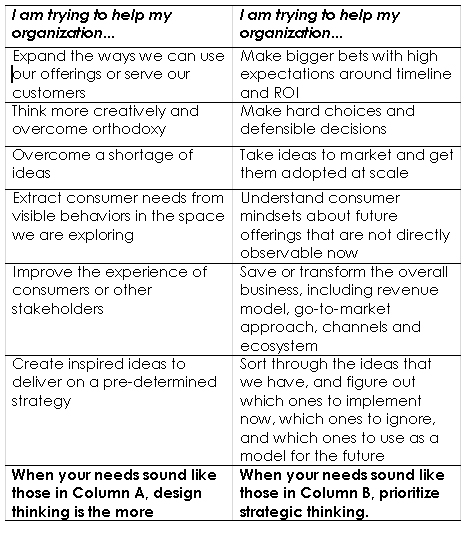
Overthinking vs. Underthinking: Finding the Sweet Spot
To escape the perils of overthinking and underthinking, leaders should be constantly wary of drifting towards neither extreme and use design to open new possibilities and strategy to make better choices
As organizations seek to foster growth, they often find themselves caught between conventional and newer approaches to innovation. While traditional strategy calls for rigorous analysis and critical thinking, design thinking espouses ‘thinking by doing’. The key is to find the sweet spot between the two approaches.
In many ways, design thinking is intended as an antidote to death by analysis. With its bias towards making, iterating and real-world learning, it often succeeds in unlocking innovation. The payoff of this approach lies in the excitement of doing things we haven’t tried before, and the emotional high that comes from breaking out of a deliberative state to take action. The first experience of design thinking thus feels energizing and liberating to organizations used to bureaucratic processes. However, applied indiscriminately, design thinking can cause a swing to the other extreme—underthinking.
Underthinking often shows up when innovation groups abruptly switch from a traditional processes to design thinking, hoping for ‘quick hits’ to impress the boss. All-too-often, the long-term return on investments in design thinking falls well short of expectations. A new idea that seemed exciting at first or an impressive customer experience might turn out to be an inadequate revenue stream, too costly to implement, or too small to save a company faced with massive business model or structural challenges. This is what can happen when your thinking targets the surface symptoms of organizational ennui, missing the underlying malady.
Capability—the realm of what you can do—is not the problem; the question is, of all the things you can do, which ones should you do? For example, of all the mobile, cloud, retail, data and service experiences you can create for your customers and partners, which ones should you create? The overload of choices is not limited to consumers alone: decision-makers inside organizations are feeling it, too.
What we need is not just action, but strategic action. Instead of knee-jerk responses to markets changes or consumer feedback, we need the patience, clarity and self-belief to make hard choices about what we are—and what we are not—about. No amount of design thinking will save you if you lack the stomach to make these tough decisions.
Take the classic rule of brainstorming—which also applies to design thinking: defer judgment. There is a time and place for deferring judgment, and that time and place is when we need to expand the possibilities available to us. The rule offers much needed relief in early-stage innovation, but it often becomes an excuse to avoid critical thinking later on in the process of creating new business models. When the need is to make hard choices and trade-offs, it’s time to bring judgment back into the picture.
To find a better balance between overthinking and underthinking, we need to apply best parts of design thinking to the strategic discipline of considering alternatives, trade-offs and opportunity costs. The question is not whether to think or build: the question is when to build, when to think, and the how of either. And the answer lies in understanding where we are on the journey of creating new opportunities.
If you’re a leader trying to help your organization thrive through uncertain times, use the following chart for some clues on whether to navigate through prototyping or through strategy.
Figure One: Where Are You in Your Innovation Journey?

The two scenarios in Figure One are stretched apart to underscore their philosophical differences in a simplified way. These are not just different processes: they represent different thinking styles and different cultures, and folks in an organization have varying degrees of training and aptitude for one or the other. As such, the dichotomy reflects the day-to-day friction between practitioners on both sides. While we are rarely presented with such clear options in practice, the onus is still on us to find the right balance between these two approaches.
Balancing the two approaches is not simply about mashing them up. Collage is a fun art form, but it’s hardly a good strategy. When leaders try to speak to both sides of the aisle, they often send mixed messages that confuse the organization. The trick is to apply the strengths of design thinking to those of strategy in specific ways.
Following are five principles that will help strategy and design thinking influence each other in productive ways, enabling innovation practitioners to avoid the extremes of overthinking and underthinking.
1. The offering is not the strategy.
Iterative prototyping is a key aspect of design thinking—it’s called ‘build to think’. But organizations should prototype the strategy part of their new business direction, not just the product or service that is a manifestation of that direction. Traditional designers experiment only on offerings, and the experiments only tell us if that particular offering worked or didn’t; it doesn’t tell us whether the thinking behind the offering was sound or unsound. As a result, too many organizations throw out the baby with the bathwater: when an idea fails, the whole direction is scrapped and the organization loses its memory of why the direction is not being pursued any more. Instead, design experiments that reveal new ways to think about your industry, organization and offerings. These thought experiments can then act as prototypes of new mental models, including insights, assumptions, hypotheses and frameworks.
2. Make Thinking Tangible.
Find ways to bring strategic thinking to life beyond PowerPoint and Excel. Try different modes of expression—visual, verbal and kinesthetic. Some people need to see visual relationships diagramed out, some like to construct arguments, and yet others need to walk through the steps by role-playing a strategic scenario. No one method is better than the others; it’s more about choosing the mode that helps you stretch your thinking and communicate more effectively with others. The key is to go beyond traditional quantitative approaches to try qualitative ones. You’ll be surprised by how many CEOs can be swayed by an exceptional emotional argument as opposed to an average numerical one.
3. Diagnose Underlying Mental Models.
Too often, designers and strategists impose their own mental models onto customers and business partners. It takes deliberate attention and specific tools to first become aware of the underlying assumptions being made on both sides, and then act upon them. To understand customers’ mental models, you have to go beyond quantified data and observational research of visible experiences to analyzing people’s stories, language and activities. This enables you to go beyond usability improvements and demographic segmentation towards psychographic, attitudinal profiles. These richer profiles are useful not just for messaging, branding and product/service design, they drive the strategic directions and go-to-market approaches that can improve the adoption of new business ideas.
4. Prototype the ‘Money’ Part, Not Just the User Experience.
For too long, design thinking has been obsessed with, and limited to, improving end-user experiences. While this is a tangible and desirable benefit, it often doesn’t deliver on the goal of creating new sources of growth that make a business sustainable, including revenue and margins. The fact is, value doesn’t flow automatically when you create a great user experience: you have to design the surrounding business system, including critical pieces like the revenue model, in order to amplify the economic impact. This is not an exercise in tweaking numbers on a spreadsheet to match expectations; it’s about configuring your business creatively to address and influence a customer’s willingness to pay. To achieve this, you need to ask questions like, Why would people want to pay for our offering? How does our offering line up with what they value? What would need to change (mindsets, market conditions, behaviours) for people to want to pay? How would we need to adapt to that change, and how can we accelerate it?
5. Define What Your Strategy Is—And What It Is Not.
Good strategy is ultimately about choices: it is as much about what not to do, as what to do. Most organizations don’t lose their way due to a lack of ideas, but by frittering away their focus and attention among thousands of seemingly useful but ultimately draining pursuits. This comes from a lack of clarity around your reason for being in existence, and the inability to draw bold lines separating ‘what will keep us on track’ vs. ‘what will lead us astray’. Next time you help create a big idea, initiative or strategy, do your company a favour and write down what it is, and in even bigger letters, what it isn’t. This includes things that customers or the media may be clamouring for. The effort needed to say no to seemingly legitimate options enforces the strategic discipline of clarifying the unique value your organization brings to people and to the market.
In closing
To escape the perils of overthinking and underthinking, leaders should be constantly wary of drifting towards either extreme. The five principles outlined herein indicate ways in which strategy and design can feed off of each other’s unique strengths. In the end, design will help to open up new possibilities, and strategy will help you choose between them.
Kingshuk Das is Innovation Strategy Advisor at EY (formerly Ernst & Young). He previously spent over 11 years working as an innovation consultant at Jump Associates, IDEO and Steelcase.
[This article has been reprinted, with permission, from Rotman Management, the magazine of the University of Toronto's Rotman School of Management]















